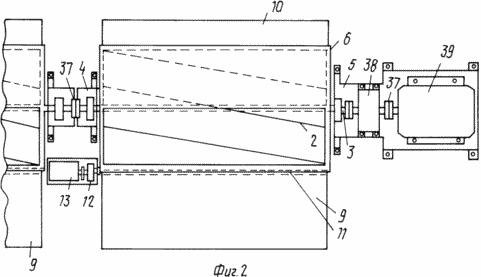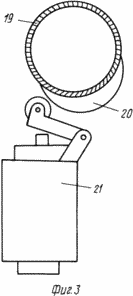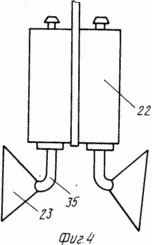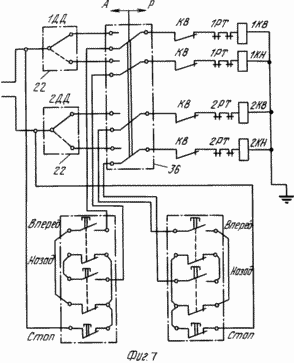| Start of section
Production, amateur Radio amateurs Aircraft model, rocket-model Useful, entertaining |
Stealth Master
Electronics Physics Technologies Inventions |
Secrets of the cosmos
Secrets of the Earth Secrets of the Ocean Tricks Map of section |
|
| Use of the site materials is allowed subject to the link (for websites - hyperlinks) | |||
Navigation: => |
Home / Patent catalog / Catalog section / Back / |
|
INVENTION
Patent of the Russian Federation RU2013644
![]()
Windmill
The name of the inventor: Cherednichenko Sergey Vasilievich
The name of the patentee: Cherednichenko Sergey Vasilievich
Address for correspondence:
Date of commencement of the patent: 1990.08.06
Application: in wind power. Essence: wind turbine contains a wind wheel with curved blades mounted on a horizontal shaft, located in a cylindrical casing, composed of upper and lower parts with slots, pivotally mounted control panels, a weather vane.
DESCRIPTION OF THE INVENTION
The invention relates to wind energy and can be used in various applications and capacities.
A windmill is known, which contains a wind wheel with curved blades mounted on a horizontal shaft, while the wind wheel is located in a casing with controllable shields, which are fixed with hinges. The wind flow is controlled by a wind vane.
The disadvantage of such a wind turbine is the elimination of the possibility of automating the process of regulating the air flow to the blades of the wind wheel.
The object of the invention is to manufacture a wind turbine with devices that automate the process of adjusting the air flow coming on the blades of the wind wheel.
The essence of this proposal is that the drum rotor with blades is located on both sides on standing bearings and is placed in a cylindrical casing with slits and end walls, consisting of two parts; Upper and lower, which are connected by means of a hinge device on one side and a fixing device on the opposite side, with shields, which are opened when necessary, secured to the casing by means of a hinge device, in the upper part of the casing and in the lower part thereof.
The hinged device of the shield includes hinge sleeves and an axle that protrudes from the casing on one side, while the protruding part of the axle is fixed by means of a coupling to the electric motor with a reducer.
The gear unit used to open and close the shield represents crossed axles with gear wheel profiles, and worm gears, which create the conditions for fixing in a certain position of the shield after the motor has stopped.
The shield of the casing, located above the horizontal shaft of the wind wheel, and the shield located below the shaft, are provided with brackets for the rigidity of the shield structures and for fixing the shield in the open position.
The casing body is fixed to the supports.
The wind turbine is equipped with limit switches, which produce a shutdown when the panels are completely opened and fully closed.
The windmill is equipped with a switch fixed directly to the wind direction indicator (weather vane) and, interacting with it, switches on or opens the motor control circuit depending on the direction of the wind.
The wind turbine is equipped with pressure sensors, which, with the automatic adjustment, switch on or off the electric motors depending on the strength of the wind.
The wind turbine is equipped with a multi-pole switch, which switches the windmotor from automatic to manual (manual) and vice versa.
The start and stop of the electric motor of the manual adjustment are made using the push-button station.
With automatic control, as well as with manual control, reversible magnetic starters are used for start-up and shutdown of motors.

FIG. 1 shows a windmill, side view.

FIG. 2 shows a windmill, top view.
 |
 |
 |
FIG. 3 shows a switch located next to the wind direction indicator (weather vane). The wind direction indicator shaft is shown in a section, top view; In Fig. 4 shows pressure sensors with reinforced airflow funnels; In Fig. 5 shows the pressure sensor, side view.
 |
 |
FIG. Figures 6 and 7 show a schematic diagram of the automatic and manual (semiautomatic) control of the wind turbine motors.
The device of the wind motor contains a tympanic wind wheel 1 with blades 2 fixed to a horizontal shaft 3 which is mounted on the standing bearings 4 and the standing bearings are fixed to the supports 5, each blade 2 being curved in cross section and fixed to the shaft 3 by a screw Line. The drum wind wheel 1 is placed in a cylindrical casing 6 with slots and end walls, the casing
Consists of two parts, the upper and lower. The upper and lower parts of the casing 6 are connected by means of a hinge device 7 and on the opposite side by means of fasteners 8. In the upper part of the casing, a shield 9 is provided, if necessary, and in the lower part of it there is a shield 10, with the shield 9 located higher Horizontal shaft 3, and shield 10 - below the shaft. The shields 9, 10 are secured to the casing by means of a hinge device 11. The hinge device 11 includes hinge sleeves and an axle which on one side protrudes from the casing and is fixed by means of a coupling sleeve 12 to an electric motor with a reduction gear 13. The motor with a gear 13 is fixed to The end wall of the casing 6, and to the support 14, which holds the casing 6. The shield 9, 10 is provided with brackets 15, which are necessary for the rigidity of the shield design, and for fixing the shield 9, 10 in the open position. From the side of the shield 9 to the support 14, the bracket 16 is fixed. In the end walls of the shell 6, in the central part of it, there are holes 17 on both sides. Each shield is provided with limit switches 18. For the need for automatic regulation of the air flow To the blades of the wind wheel 1, in the vicinity of the windmill, there is a wind direction indicator (weather vane) 19, on whose rotating shaft a crocker 20 is fixed. A power switch 21 has been fixed to the rotating shaft. To determine whether the shield 9,10 needs to be opened or closed, the wind turbine in automatic control mode is equipped with Pressure sensors 22 with reinforced airflow funnels 23. The pressure sensor consists of a housing 24, a bellows-type sensing element 25, a tuning spring 26, a fixing washer 27, a handwheel 28, a sleeve 29 secured to a microswitch 30, a spring 31, a safety nut 32 To connect the pressure sensor to the electrical circuit, three wires 33 are provided through the gland packing 34. A hollow bent rod 35 is connected to the funnel of the trap 23, and the latter, in turn, is connected to the relay 22 by its free end. Manual operation of the control of the switchboards 9, 10, the switch 36 is used. In addition, the electric motor control system of the switchboards 9, 10 consists of reversing starters and push-button stations. When using a wind turbine as part of an energy device, for example, in a wind power plant, the horizontal shaft 3 is connected from separate parts by means of coupling sleeves 37, with a drum wind wheel 1 mounted on each individual shaft part, and each housing 6 with a wind wheel 1 located inside After the other with a gap between each other. In addition, the shaft 3 is connected at one end via a reducer 38 to an electric generator 39. At the other end of the shaft 3, a pulley 40 is mounted, with which, if necessary, another actuator, for example, a pump drive, can be connected. For repair work and routine maintenance work with the wind wheel or other part of the windmill, the braking device 41 is mounted on the shaft 3.
THE WINDROVER IS USED AS FOLLOWING
Having determined the place of installation, the wind turbine is installed in such a way that the upper part of the casing from the side of the shield 9, which opens if necessary, would be oriented towards the advantageous direction of the wind. When the electric power (emergency lighting) is connected to the control system, for example, of the switchboard 9, the electric motor 13 is turned on and, creating its forces through the reducer to the axis of the hinge device 11, opens the shield 9 as much as necessary for normal rotation of the wind wheel. At this time, the air flow, falling into the space of the casing 6, causes the rotation of the wind wheel 1, which transmits wind forces to the reduction gear 38, and then to the generator 39 generating electrical energy. Air flow, falling into a closed space, moves in a circle in a cylindrical casing, while acting on the blades of the wind wheel.
When the motor is automatically turned on and off, for example, the control panel 9, the control system operates as follows. When the airflow of sufficient speed arrives, the shaft of the wind direction indicator (weathervane) 19 will rotate so that the crumb 20 will press the switch of the power switch 21, which in turn, by pressing the switch button, switches the control system (phase wire) in the required direction, for example , The control circuit of the switchgear board 9. In this connection, the electric current passes through the first pressure sensor 22. Here, the pressure sensor using the trap catchers 23 and certain wind forces on the sensing element 25, which, when moving, acts on the button of the microswitch 30, The opening of the shield 9. In this connection, the electric current passes through the terminal of this pressure sensor, through the closed terminal of the multi-pole switch 36 (in Figure 7, the switch 36 is switched to the manual wind turbine operation mode), and through the limit switch 18 mounted on the bracket 16 , The thermal relay and through the coil IKB. Since one of the ends of the coil is connected to a neutral wire that is operative in the proposed scheme, then in the coil 1KB at that moment a magnetic field arises that will attract the core together with the movable contacts of the IKB which, closing with the fixed contacts of the IKB of the reversing magnetic starter, Electric motor, opening the switchboard 9. When the switchboard is fully opened, the limit switch 18 opens, disconnecting the electric circuit of the coil IKB, as a result of which the main power contacts of the starter IKB open and the motor stops. When the wind increases above the norm, even up to the storm, the shield 9 is automatically closed, while the wind flow, entering the trap funnel through the hollow curved rod 35, creates its forces on the sensing element of the pressure sensor 25 and adjusting spring 26.
The sensing element, creating forces on the button of the microswitch 30, opens the coil circuit of the IKB, while the microswitch terminal, moving higher, closes the upper contacts. In this case, the electric current passes through this terminal, via a multi-pole switch, through the limit switch 18 located on the housing 6, through the thermal relay of the starter and the coil IKN. In this case, the motor 13 is turned on in the reverse direction, closing the shield 9. At this point, the limit switch 18 located on the bracket 16 closes the circuit for the coil of the IKB, making it ready to turn on. In addition, in the event of a weakening of the wind flow during closure of the shield 9, the upper contacts are opened and the motor 13 is stopped, while the shield 9 is in a semi-closed position, and the micro switch switch 30 is located between the upper and lower contacts. In the case of persistent wind amplification, the upper terminals again close, connecting the electric circuit for the coil IKN, while the electric motor 13 switches on, closing the shield 9. When the shield 9 is completely closed, the limit switch 18 located on the casing opens the coil circuit of the IKH, resulting in the main power contacts IKN starters are opened and the motor stops. When the wind decreases to normal values, the microswitch terminal is lowered, closing the lower contacts, including the coil circuit of the IKB. The electric motor is switched on, opening the shield 9 for wind turbine operation. If the direction of the wind changes to the opposite wind direction indicator shaft (vane), the shaft turns to the opposite side, as a result of which the toaster 20 releases the switch of the power switch 21, and the lever in turn releases the button of this switch. As a result, the previously closed and closed other control circuit will open, that is, the electric circuit of the electric motor of the switchboard 10 (Fig.6, 7). In this case, the electric control circuit will pass through a second pressure sensor in accordance with the circuit of FIG. 6, 7. The automated opening and closing of the shield 10 is carried out in the same way as it is made for the shield 9.
For the most favorable rotation speed of the wind wheel 1, the pressure sensors are adjusted. To do this, the handwheel 28 fixing the washers 27 and the safety nut 32 is pressed or lowered by the adjustment spring 26 of the sensor element 25 in order to slow or accelerate the process of switching the pressure sensor. If, for example, the adjustment spring 26 is pressed, the closing time of the shield 9, 10 will be slowed down, while the wind wheel will use a higher wind speed. Manual (manual) control is performed if the pressure sensor 22 is repaired or if any part of the switchboard 9, 10 is checked after repair. In this connection, if necessary, to open, for example, the shield 9, the button "Forward" of the key station is pressed. This button is connected to the control system (phase wire) passing through the "Stop" button, but also with the closed blocking contact of the "Back" button. At the moment of pressing the "Forward" button, the electric current passes through the terminals of this button, the closed contacts of the multi-pole switch 36, the limit switch 18 located on the bracket 16, through the thermal relay of the starter and the coil IKB, where, when encountering the zero wire, a magnetic field is created which Attracts the core of the magnetic starter together with the movable contacts of the IKB of the reversing magnetic starter, while the electric motor is turned on, opening the shield 9 as much as necessary. If you press the "Next" button, then the contacts of this button are opened. The electrical circuit of the coil IKB also opens, as a result of which the core of the magnetic starter opens with the power contacts IKB and the motor stops. The motor of the switchboard 9 is turned on in the opposite direction if the "Back" button is pressed. This button is connected to the closed control system (phase wire) passing through the "Stop" button and through the closed blocking contacts "Forward" buttons. At the moment the button "Back" is pressed, the current flows through the terminals of this button, through the closed contacts of the multi-pole switch 36 (Figure 7), through the limit switch 18 located on the windmill housing, through the thermal relay of the starter and the coil IKN, where, Wire, a magnetic field is created that attracts the starter core together with the movable contacts, as a result of which the movable contacts IKH turn on the motor of the switchboard 9 with rotation in the other direction, according to the proposed scheme, thereby closing the shield 9. In case of changing the wind direction to the opposite opening and The closure of the switchboard 10 will be the same as the opening and closing of the switchboard 9. However, in this case, another push-button station and the 2KB and 2KN starter devices will be engaged, in accordance with the circuit of FIG. 6.
The application of the proposed wind turbine creates an advantage over the known devices in that, with the use of such a wind turbine, it becomes possible to automate the process of adjusting the air flow entering the blades of the wind wheel. In addition, it becomes possible to use wind energy in places where the strongest movement of air flows occurs.
CLAIM
1. Wind turbine, comprising a wind wheel with curved blades mounted on a horizontal shaft, located in a casing with hinged controllable shields, and a weather vane, characterized in that, in order to improve the accuracy of adjustment, the casing is made cylindrical from the composed upper and lower parts with slots, And the shields are hingedly connected to the housing parts.
2. Wind turbine according to claim 1, characterized in that the control system is equipped with pressure sensors with flow collectors.
Wind turbine according to. 1 and 2, characterized in that the weathercock is equipped with a crock, reinforced on the weather vane shaft, and the control system by limit switches, reversing magnetic starters, an electric power switch, the latter being mounted with the possibility of interaction with the weathervane crock.
4. Wind turbine according to. 1 - 3, characterized in that the control system is provided with a multi-sectional power switch.
print version
Date of publication 11.02.2007gg




Comments
When commenting on, remember that the content and tone of your message can hurt the feelings of real people, show respect and tolerance to your interlocutors even if you do not share their opinion, your behavior in the conditions of freedom of expression and anonymity provided by the Internet, changes Not only virtual, but also the real world. All comments are hidden from the index, spam is controlled.